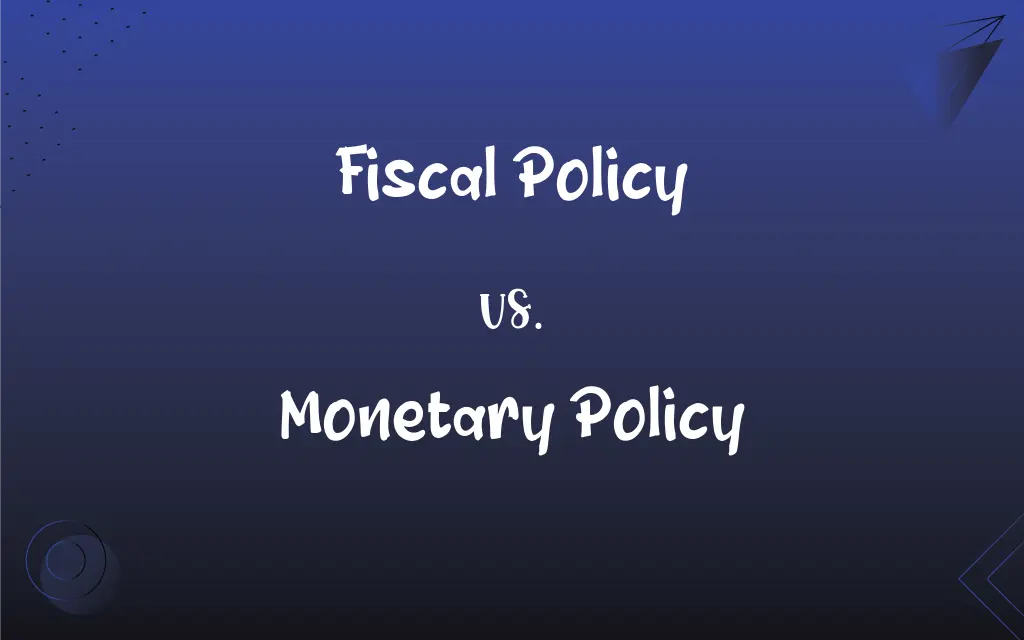Fiscal Policy vs. Monetary Policy: What's the Difference?
Edited by Aimie Carlson || By Harlon Moss || Updated on October 11, 2023
Fiscal policy involves government spending and taxation to manage the economy, while monetary policy involves central bank activities, like managing interest rates and money supply, to control inflation and stabilize currency.

Key Differences
Fiscal policy is paramount in steering a country’s economic direction. It encompasses how a government adjusts its spending levels and tax rates to monitor and influence a nation’s economy. Fiscal policy plays a critical role in stabilizing the economic cycle, facilitating growth, and managing inflation and unemployment levels. The implementation of fiscal policy is typically encapsulated in a government’s budget, reflecting its economic priorities and strategies.
Monetary policy, on the other hand, primarily focuses on managing the amount and rate of growth of a nation's money supply. It is usually managed by a central bank and involves manipulating interest rates and other tools to either stimulate economic growth or cool down an overheated economy. The objective of monetary policy is to achieve low inflation, high employment, and economic stability. Monetary policy makers often navigate between stimulating the economy and stifling inflation, striving for a balanced approach.
In fiscal policy, governments can adopt an expansionary stance to stimulate the economy or a contractionary one to cool it down. Expansionary fiscal policy entails increasing government spending or reducing taxes to spur economic activity. Conversely, contractionary fiscal policy involves decreasing government spending or increasing taxes to mitigate inflation and overheating. Fiscal policy, therefore, directly impacts the available government spending in various sectors like health, education, and infrastructure.
Monetary policy too, employs either an expansionary or contractionary approach. Expansionary monetary policy involves reducing interest rates and potentially conducting open market operations to boost money supply and stimulate economic activity. Meanwhile, contractionary monetary policy includes raising interest rates and reducing the money supply to combat inflation. The monetary policy, while macroeconomic in nature, trickles down to impact consumers in the form of loan interest rates and credit availability.
Both fiscal policy and monetary policy are crucial for economic management and stability. Fiscal policy reflects government priorities and involves direct spending and taxation, directly influencing employment, infrastructure, and public services. Monetary policy, by contrast, is more about maintaining economic stability through control of the money supply and is inherently tied to financial markets and institutions. While these policies are distinct and managed by different entities, they must be coordinated and harmonious to ensure optimal national economic performance.
ADVERTISEMENT
Comparison Chart
Managing Entity
Managed by the government, typically through various ministries.
Managed by the central bank of a country.
Main Tools
Utilizes government spending and taxation.
Employs interest rate manipulation and control of money supply.
Primary Objectives
Aims to stabilize and stimulate the economy and manage unemployment levels.
Primarily focused on controlling inflation and stabilizing currency.
Direct Impact
Has a direct impact on government services and public sector employment.
Directly affects borrowing costs and credit availability.
Speed of Implementation
Can be slow due to legislative processes required for changes in taxation or significant spending.
Can be implemented relatively quickly as central banks can adjust rates and perform open market operations swiftly.
ADVERTISEMENT
Fiscal Policy and Monetary Policy Definitions
Fiscal Policy
Fiscal policy impacts income distribution through its influence on taxation and government spending.
The revised fiscal policy aimed at reducing income inequality through progressive taxation.
Monetary Policy
Monetary policy impacts various economic aspects, such as inflation rates, employment levels, and overall economic stability, by managing monetary conditions.
During economic stability, a neutral stance on monetary policy is often maintained to ensure that inflation and employment remain in check.
Fiscal Policy
Contractionary fiscal policy involves reducing government expenditures or raising taxes to cool down an overheated economy.
The government utilized a contractionary fiscal policy to curb rampant inflation.
Monetary Policy
Monetary policy tools include open market operations, discount rates, and reserve requirements that central banks use to implement their policy stance.
Open market operations, a key monetary policy tool, involve the buying and selling of government securities to regulate the money supply.
Fiscal Policy
Fiscal policy involves government modifications in spending and taxation to influence the national economy.
The government introduced a new fiscal policy that increased infrastructure spending to stimulate economic activity.
Monetary Policy
Monetary policy refers to the strategies employed by a central bank to control and stabilize the country’s money supply and interest rates.
The Federal Reserve implements monetary policy to manage inflation and stabilize the U.S. economy.
Fiscal Policy
Fiscal policy can directly affect employment levels through altering government spending on public services and projects.
The boost in fiscal policy resulted in numerous public works projects, enhancing employment rates.
Monetary Policy
Contractionary monetary policy involves reducing the money supply or raising interest rates to cool an overheating economy and control inflation.
The central bank employed a contractionary monetary policy to tame the burgeoning inflation rates and stabilize prices.
Fiscal Policy
Expansionary fiscal policy seeks to spur economic activity through increased spending or tax reductions.
In the recession, an expansionary fiscal policy was adopted to invigorate the slowing economy.
Monetary Policy
Expansionary monetary policy is designed to boost the economy by increasing the money supply and/or lowering interest rates.
During the financial crisis, an expansionary monetary policy was adopted to stimulate economic activity and prevent recession.
FAQs
Who is responsible for implementing fiscal policy?
Fiscal policy is implemented by the government, usually through its finance or treasury departments.
What is the main objective of fiscal policy?
Fiscal policy aims to stabilize the economic cycle, manage inflation, and facilitate growth through government spending and taxation.
How does fiscal policy impact unemployment?
Fiscal policy can influence unemployment levels through government spending on projects and services that create jobs.
What is a contractionary fiscal policy?
Contractionary fiscal policy entails reducing government spending or raising taxes to cool an overheated economy.
What does contractionary monetary policy entail?
Contractionary monetary policy seeks to reduce the money supply and/or increase interest rates to control inflation and stabilize the economy.
Can fiscal and monetary policy conflict with each other?
Yes, if the objectives are not aligned, for example, if the fiscal policy is expansionary while the monetary policy is contractionary, they can work against each other.
Why is coordination between fiscal and monetary policy important?
Coordination ensures that the policies are mutually reinforcing and do not counteract each other, enabling effective management of the economy.
Can monetary policy alone stabilize an economy?
While monetary policy is a powerful tool, it is generally most effective when used in conjunction with sound fiscal policy, especially in extreme economic conditions.
What is expansionary monetary policy?
Expansionary monetary policy involves increasing the money supply and/or reducing interest rates to stimulate economic growth.
How quickly can fiscal policy be implemented?
Fiscal policy might be slower to implement due to the requirement of legislative approval for tax changes or significant spending.
How does fiscal policy impact inflation?
By altering spending and taxation levels, fiscal policy can either fuel or cool inflationary pressures.
What is an expansionary fiscal policy?
Expansionary fiscal policy involves increasing government spending or reducing taxes to stimulate economic activity.
What is the primary purpose of monetary policy?
The primary purpose of monetary policy is to control inflation and stabilize the national currency by managing the money supply and interest rates.
Can monetary policy address income inequality?
Monetary policy generally has a less direct impact on income inequality compared to fiscal policy, which can more directly address it through taxation and spending strategies.
How often is monetary policy reviewed?
The frequency of monetary policy review varies by country but central banks generally meet several times a year to assess and adjust policy.
How do fiscal policy and monetary policy impact the exchange rate?
Fiscal and monetary policies influence interest rates and economic performance, which in turn affect currency values and exchange rates in the foreign exchange market.
Who implements monetary policy in a country?
Monetary policy is typically implemented by a country’s central bank.
How does monetary policy affect interest rates?
Central banks manipulate interest rates as a key tool in implementing monetary policy, affecting loan costs and credit availability.
Can fiscal policy be utilized to address economic inequality?
Yes, through progressive taxation and targeted spending, fiscal policy can be structured to address economic inequality.
How does monetary policy influence unemployment?
By affecting economic activity through control of the money supply and interest rates, monetary policy indirectly impacts unemployment levels.
About Author
Written by
Harlon MossHarlon is a seasoned quality moderator and accomplished content writer for Difference Wiki. An alumnus of the prestigious University of California, he earned his degree in Computer Science. Leveraging his academic background, Harlon brings a meticulous and informed perspective to his work, ensuring content accuracy and excellence.
Edited by
Aimie CarlsonAimie Carlson, holding a master's degree in English literature, is a fervent English language enthusiast. She lends her writing talents to Difference Wiki, a prominent website that specializes in comparisons, offering readers insightful analyses that both captivate and inform.































































